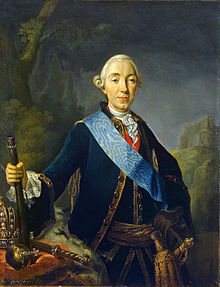Miracle of the House of Brandenburg

The Miracle of the House of Brandenburg (also called the Miracle of the House of Brandenburg ), French Miracle de la maison (de) Brandenbourg , is usually used to describe the rescue of Prussia in the Seven Years' War through the death of the Russian Empress Elisabeth on January 5, 1762. Her successor Peter III . terminated the alliance with Austria and on May 5, 1762 concluded the peace and alliance treaty of Saint Petersburg with the Prussian King Friedrich II . Peter was murdered on July 17, 1762 and his successor Catherine II dissolved the alliance, but continued to keep the peace.
In fact, the term comes "Miracle of the House of Brandenburg" However, from a letter to his brother Frederick Henry of September 1, 1759. A few days earlier, on August 12, Friedrich was of the allied Russians and Austrians in the Battle of Kunersdorf been defeated . Friedrich's opponents, however, did not take advantage of this victory to advance on Berlin ; with the capture of the Prussian capital the war would have been lost in Friedrich's opinion. The rescue from impending defeat reported facilitated Friedrich his brother by the "miracle of the House of Austria", the many wonderful , she rescues the House of Habsburg through all kinds of saints, and satirizing "miracle" proclaimed :
literature
- Johannes Kunisch : The miracle of the House of Brandenburg. Studies on the relationship between cabinet politics and warfare in the age of the Seven Years' War , Munich 1978, ISBN 3-486-48481-8 (Kunisch neither explains the origin of the term "Miracle of the House of Brandenburg" nor does he mention the quote from Friedrich's letter of September 1, 1759)
Individual proof
- ↑ Reinhold Koser pointed to this connection in: History of Frederick the Great. Fourth and fifth increased editions. Third volume , Cotta'sche Buchhandlung Nachhaben, Stuttgart / Berlin 1913. p. 38 out; there also the quotation, evidence in the fourth volume, p. 87.